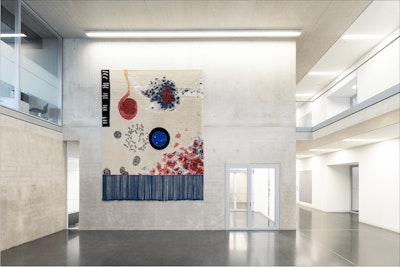Has the Luxembourg government (finally) found a way to create a durable alliance between public procurement and contemporary art? With the Law of 8 March 2023 coming into force, it has in any case provided the legal framework for artworks to be routinely integrated into public buildings. Inspired by similar schemes in neighbouring countries, the bill stipulates that a provision of 1% of the construction cost of any building financed by the Luxembourg state must be made for the acquisition or commissioning of a work of art to be exhibited on site. Capped at €500,000, the measure also applies to the renovation, refurbishment or extension of public buildings. The aim is to give artists greater visibility while raising awareness of contemporary art across all audiences, from schoolchildren, pensioners and art lovers to passers-by. Reaching out to as many people as possible through direct contact with art is the main purpose of publicly commissioned artworks.
This marriage (of convenience) between the art market and public procurement requires the Ministry of Culture to cooperate closely with the Administration des Bâtiments Publics, the department in charge of public buildings. This involves a complex procedure based on inter-ministerial consultation, exchanges of views and complementary skill sets. For each project, a call for applications is published. An Artistic Committee made up of experts and a representative of the Ministry of Culture selects a winner among the applicants in cooperation with the contracting authority. During this process, the Artistic Committee is assisted by an Artistic Planning Commission, which advises the stakeholders throughout the project. To help them through this sometimes long and tedious process, the Ministry of Culture has published a guide for artists and developers on its website.
The scheme has allowed some outstanding examples of public art to be implemented, such as the tapestry created by Justine Blau for the Laboratoire National de Santé (3,0.1013, 2020) or Serge Ecker’s polygons disseminated across the Luxexpo interchange (Urban Corals, 2021). Other remarkable projects include the sculpture trail conceived this summer by Martine Feipel and Jean Bechameil for the garden of the Bibliothèque Nationale du Luxembourg (Futurs possibles, passés probables, 2023), Trixi Weis’s astonishing City Clock (2013) at the entrance to radio station 100.7, and Tina Gillen’s installation in the House of Commons (called Chamber of Deputies). Thanks to this measure, other public facilities, such as hospitals, secondary schools and retirement homes, now also accommodate works of art and act as a kind of ‘community gallery’.
However, once works of art are on public display, they must be brought to the attention of the general public by means of outreach activities in order to come alive. Attention also needs to be paid to the conservation and protection of the works over time. When works of art venture outside the white cube, they enter into a dialogue with the existing architecture and the urban landscape, often to revisit the history and forgotten function of a place while endowing it with symbolic value. These varied aspects need to be taken into account if publicly commissioned works are to generate a dynamic that contributes to boosting the city’s international appeal.
But even before the new law come into force, various high-profile public projects have been implemented. As early as 1996, Richard Serra was invited by Fonds Kirchberg to contribute a monumental sculpture on a roundabout (Exchange) to the urban development of the Kirchberg business area. The Fonds is indeed a pioneering instance in public art commissions in Luxembourg, initiating numerous other projects such as Ulrich Rückriem’s steles (Skulptur ohne Titel – Variationen zum Thema Bildstock, 1993) or Luxembourg artist Su-Mei Tse’s poetic Bird Cage (2009) in the heart of the business district.
During her tenure as Minister of Culture, Sam Tanson has tabled various bills and measures in support of contemporary art. In 2021, her department set up an Artothèque that has been tasked with the acquisition and promotion of contemporary artworks. This state collection currently comprises over 700 works of art across all media (drawings, engravings, sculptures). Acquisitions are made by a specially appointed commission based on a call for applications aimed at Luxembourg-based artists and galleries. Works by Marco Godinho, Flora Mar, Bruno Baltzer and Leonora Bisagno, among others, have thus recently entered this public collection.
Since February 2021, Casino Luxembourg – Forum d’art contemporain has been running a programme entitled Casino Display, which aims to promote young emerging artists through training, research and exhibition projects. The scheme is based on collaborations with renowned art schools in the Greater Region, including ESAL in Metz, ENSAD in Nancy, HEAR in Strasbourg-Mulhouse and HBKsaar in Saarbrücken.
Besides several prizes and awards aimed at encouraging or supporting professional artists, a number of alternative venues were created in the wake of Esch2022, European Capital of Culture. The inauguration of Konschthal, a dedicated exhibition centre, in October 2021 has significantly raised the profile of contemporary art in the former mining town of Esch/Alzette. Konschthal, which is currently showing Flying Mercury a solo exhibition by Tina Gillen, was launched alongside two other experimental venues: Bridderhaus, a former hospital converted into a residency and exhibition space, and Bâtiment4, an annexe of ARBED that has been redeveloped into a venue where art intertwines with alternative ways of living (local food movement, recycling of industrial leftovers, transmission of skills, etc.). Esch/Alzette is also home to the Grand Duchy’s first ecovillage, where art is used as a means to reach out to socially disadvantaged communities. The Ministry of Culture encourages all these initiatives by advocating an ecological approach across the sector. It is against the backdrop of this particularly dynamic ecosystem that the ninth edition of Luxembourg Art Week will unfold.


